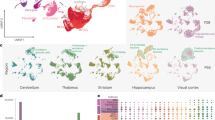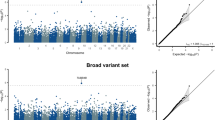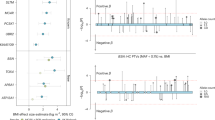Abstract
Epilepsy is a common neurological disorder, and mutations in genes encoding ion channels or neurotransmitter receptors are frequent causes of monogenic forms of epilepsy. Here we show that abnormal expansions of TTTCA and TTTTA repeats in intron 4 of SAMD12 cause benign adult familial myoclonic epilepsy (BAFME). Single-molecule, real-time sequencing of BAC clones and nanopore sequencing of genomic DNA identified two repeat configurations in SAMD12. Intriguingly, in two families with a clinical diagnosis of BAFME in which no repeat expansions in SAMD12 were observed, we identified similar expansions of TTTCA and TTTTA repeats in introns of TNRC6A and RAPGEF2, indicating that expansions of the same repeat motifs are involved in the pathogenesis of BAFME regardless of the genes in which the expanded repeats are located. This discovery that expansions of noncoding repeats lead to neuronal dysfunction responsible for myoclonic tremor and epilepsy extends the understanding of diseases with such repeat expansion.
This is a preview of subscription content, access via your institution
Access options
Access Nature and 54 other Nature Portfolio journals
Get Nature+, our best-value online-access subscription
$29.99 / 30 days
cancel any time
Subscribe to this journal
Receive 12 print issues and online access
$209.00 per year
only $17.42 per issue
Buy this article
- Purchase on Springer Link
- Instant access to full article PDF
Prices may be subject to local taxes which are calculated during checkout






Similar content being viewed by others
References
Inazuki, G. et al. A clinical study and neuropathological findings of a familial disease with myoclonus and epilepsy–the nosological place of familial essential myoclonus and epilepsy (FEME). Psych. Neurol. Jpn. 92, 1–21 (1990).
Ikeda, A. et al. Cortical tremor: a variant of cortical reflex myoclonus. Neurology 40, 1561–1565 (1990).
Yasuda, T. Benign adult familial myoclonic epilepsy (BAFME). Kawasaki Med. J. 17, 1–13 (1991).
Plaster, N. M. et al. Genetic localization of the familial adult myoclonic epilepsy (FAME) gene to chromosome 8q24. Neurology 53, 1180–1183 (1999).
Mikami, M. et al. Localization of a gene for benign adult familial myoclonic epilepsy to chromosome 8q23.3-q24.1. Am. J. Hum. Genet. 65, 745–751 (1999).
Suzuki, T. Clinical genetics and linkage analysis of familial essential myoclonus and epilepsy (FEME). Niigata Igakkai Zasshi (in Japanese) 116, 535–545 (2002).
Uyama, E., Fu, Y. H. & Ptácek, L. J. Familial adult myoclonic epilepsy (FAME). in Advances in Neurology Vol. 95: Myoclonic Epilepsies (eds. A. V. Delgado-Escueta et al.) 281–288 (Lippincott Willams & Wilkins, Philadelphia, 1995).
Mori, S. et al. Remapping and mutation analysis of benign adult familial myoclonic epilepsy in a Japanese pedigree. J. Hum. Genet. 56, 742–747 (2011).
Cen, Z. D. et al. Fine mapping and whole-exome sequencing of a familial cortical myoclonic tremor with epilepsy family. Am. J. Med. Genet. Part B 168, 595–599 (2015).
Guerrini, R. et al. Autosomal dominant cortical myoclonus and epilepsy (ADCME) with complex partial and generalized seizures: A newly recognized epilepsy syndrome with linkage to chromosome 2p11.1-q12.2. Brain 124, 2459–2475 (2001).
Depienne, C. et al. Familial cortical myoclonic tremor with epilepsy: the third locus (FCMTE3) maps to 5p. Neurology 74, 2000–2003 (2010).
Yeetong, P. et al. A newly identified locus for benign adult familial myoclonic epilepsy on chromosome 3q26.32-3q28. Eur. J. Hum. Genet. 21, 225–228 (2013).
Beck, J. et al. Large C9orf72 hexanucleotide repeat expansions are seen in multiple neurodegenerative syndromes and are more frequent than expected in the UK population. Am. J. Hum. Genet. 92, 345–353 (2013).
Li, H. Minimap and miniasm: fast mapping and de novo assembly for noisy long sequences. Bioinformatics 32, 2103–2110 (2016).
Benson, G. Tandem repeats finder: a program to analyze DNA sequences. Nucleic Acids Res. 27, 573–580 (1999).
Hitomi, T. et al. Clinical anticipation in Japanese families of benign adult familial myoclonus epilepsy. Epilepsia 53, e33–e36 (2012).
Hitomi, T. et al. Increased clinical anticipation with maternal transmission in benign adult familial myoclonus epilepsy in Japan. Epileptic Disord. 15, 428–432 (2013).
Yoshida, K. et al. Distinctive features of degenerating Purkinje cells in spinocerebellar ataxia type 31. Neuropathology 34, 261–267 (2014).
Miyake, N. et al. Biallelic TBCD mutations cause early-onset neurodegenerative encephalopathy. Am. J. Hum. Genet. 99, 950–961 (2016).
Ameur, A. et al. Total RNA sequencing reveals nascent transcription and widespread co-transcriptional splicing in the human brain. Nat. Struct. Mol. Biol. 18, 1435–1440 (2011).
Haeusler, A. R. et al. C9orf72 nucleotide repeat structures initiate molecular cascades of disease. Nature 507, 195–200 (2014).
Doi, K. et al. Rapid detection of expanded short tandem repeats in personal genomics using hybrid sequencing. Bioinformatics 30, 815–822 (2014).
Uhlén, M. et al. Proteomics. Tissue-based map of the human proteome. Science 347, 1260419 (2015).
Arcot, S. S., Wang, Z., Weber, J. L., Deininger, P. L. & Batzer, M. A. Alu repeats: a source for the genesis of primate microsatellites. Genomics 29, 136–144 (1995).
Kurosaki, T., Matsuura, T., Ohno, K. & Ueda, S. Alu-mediated acquisition of unstable ATTCT pentanucleotide repeats in the human ATXN10 gene. Mol. Biol. Evol. 26, 2573–2579 (2009).
Sato, N. et al. Spinocerebellar ataxia type 31 is associated with “inserted” penta-nucleotide repeats containing (TGGAA)n. Am. J. Hum. Genet. 85, 544–557 (2009).
Taneja, K. L., McCurrach, M., Schalling, M., Housman, D. & Singer, R. H. Foci of trinucleotide repeat transcripts in nuclei of myotonic dystrophy cells and tissues. J. Cell Biol. 128, 995–1002 (1995).
Matsuura, T. et al. Large expansion of the ATTCT pentanucleotide repeat in spinocerebellar ataxia type 10. Nat. Genet. 26, 191–194 (2000).
Hagerman, R. J. et al. Intention tremor, parkinsonism, and generalized brain atrophy in male carriers of fragile X. Neurology 57, 127–130 (2001).
DeJesus-Hernandez, M. et al. Expanded GGGGCC hexanucleotide repeat in noncoding region of C9ORF72 causes chromosome 9p-linked FTD and ALS. Neuron 72, 245–256 (2011).
Renton, A. E. et al. A hexanucleotide repeat expansion in C9ORF72 is the cause of chromosome 9p21-linked ALS-FTD. Neuron 72, 257–268 (2011).
Hitomi, T. et al. Increased cortical hyperexcitability and exaggerated myoclonus with aging in benign adult familial myoclonus epilepsy. Mov. Disord. 26, 1509–1514 (2011).
Charlet-B, N. et al. Loss of the muscle-specific chloride channel in type 1 myotonic dystrophy due to misregulated alternative splicing. Mol. Cell 10, 45–53 (2002).
Mankodi, A. et al. Expanded CUG repeats trigger aberrant splicing of ClC-1 chloride channel pre-mRNA and hyperexcitability of skeletal muscle in myotonic dystrophy. Mol. Cell 10, 35–44 (2002).
Zu, T. et al. Non-ATG-initiated translation directed by microsatellite expansions. Proc. Natl. Acad. Sci. USA 108, 260–265 (2011).
Sanpei, K. et al. Identification of the spinocerebellar ataxia type 2 gene using a direct identification of repeat expansion and cloning technique, DIRECT. Nat. Genet. 14, 277–284 (1996).
Henden, L. et al. Identity by descent fine mapping of familial adult myoclonus epilepsy (FAME) to 2p11.2-2q11.2. Hum. Genet. 135, 1117–1125 (2016).
Fukuda, Y. et al. SNP HiTLink: a high-throughput linkage analysis system employing dense SNP data. BMC Bioinformatics 10, 121 (2009).
Gudbjartsson, D. F., Thorvaldsson, T., Kong, A., Gunnarsson, G. & Ingolfsdottir, A. Allegro version 2. Nat. Genet. 37, 1015–1016 (2005).
Regan, J. F. et al. A rapid molecular approach for chromosomal phasing. PLoS One 10, e0118270 (2015).
Li, H. & Durbin, R. Fast and accurate short read alignment with Burrows-Wheeler transform. Bioinformatics 25, 1754–1760 (2009).
Li, H. et al. The sequence alignment/map format and SAMtools. Bioinformatics 25, 2078–2079 (2009).
Zheng, G. X. Y. et al. Haplotyping germline and cancer genomes with high-throughput linked-read sequencing. Nat. Biotechnol. 34, 303–311 (2016).
Kim, D. et al. TopHat2: accurate alignment of transcriptomes in the presence of insertions, deletions and gene fusions. Genome Biol. 14, R36 (2013).
Trapnell, C. et al. Transcript assembly and quantification by RNA-Seq reveals unannotated transcripts and isoform switching during cell differentiation. Nat. Biotechnol. 28, 511–515 (2010).
Acknowledgements
We thank the patients and family members for participating in the study. We thank T. Sekiya (Department of Neurology, Sumitomo Hospital, Osaka, Japan), M. Kinoshita (Department of Neurology, Utano National Hospital, National Hospital Organization, Kyoto, Japan), M. Kanda (Department of Neurology, Ijinkai Takeda General Hospital, Kyoto, Japan), K. Hokkoku (Department of Neurology, Teikyo University School of Medicine, Tokyo, Japan) and others for kindly collecting and providing clinical information, and K. Hirayama, Zhenghong Wu, M. Takeyama, K. Wakabayashi, N. Maruyama, T. Sugai, and Y. Tsukamoto for technical support. This work was supported in part by KAKENHI (Grants-in-Aid for Scientific Research on Innovative Areas 22129001 and 22129002) from the Ministry of Education, Culture, Sports, Science and Technology of Japan, and Grants-in-Aid (H23-Jitsuyoka (Nanbyo)-Ippan-004 and H26-Jitsuyoka (Nanbyo)-Ippan-080) from the Ministry of Health, Welfare and Labour, Japan, and grants (15ek0109065h0002, 16kk0205001h0001, 17kk0205001h0002 and 17ek0109279h0001) from the Japan Agency for Medical Research and Development (AMED) to S.T. This work was also supported by KAKENHI (Grant-in-Aid for Young Scientists 17H05085) from the Japan Society for the Promotion of Science for H.I.
Author information
Authors and Affiliations
Contributions
H.I. and S.T. designed the study; H.I., J.M., M.K.M., A.F., Y. Toyoshima, A. Kakita, H. Takahashi, Y. Suzuki, S. Sugano, H.Y., S. Shibata, A.M., M. Tanaka, Y.I., Y. Takahashi, H.D., T.M., J.S., N.O.-Y., S.I., J.G., S.M. and S.T. performed the experiments and analyzed the data; H.I., K.D., J.Y., Y. Suzuki, W.Q., K.I., K.H., H.D. and S.M. performed computational analysis; H.I., M.K.M., Y. Toyoshima, A.K., H. Takahashi and S.T. performed neuropathological analyses; H.I., J.M., M.K.M., Y. Toyoshima, A.K., H. Takahashi, M. Tanaka, Y.I., Y. Takahashi, T.M., S. Shibata., J.K., F.K.N., M. Higashihara, K.A., R.K., M.S., Y.K., N.H., N.K., T.K., T. Hitomi, M. Tada, H. Takano, Y. Saito, K.S., O.O., M. Nishizawa, M. Nakamura, T.Y., Y. Sakiyama, M.O., A.U., K. Kaida, R.H., T. Hayashi, Y. Terao, S.I.-T., M. Hamada, Y. Shirota, A. Kubota, Y.U., K. Koh, Y. Takiyama, R.Y., A.T., H.A., T.O., A.S. and A.I. collected and analyzed clinical data and provided patients’ samples; and H.I., M.K.M., A. Kakita, S.M. and S.T. wrote the manuscript, together with contributions from all authors.
Corresponding author
Ethics declarations
Competing interests
The authors declare no competing financial interests. A.I. currently belongs to The Department of Epilepsy, Movement Disorders and Physiology, Graduate School of Medicine, Kyoto University, which is an endowment department supported with a grant from GlaxoSmithKline K.K., NIHON KOHDEN CORPORATION, Otsuka Pharmaceuticals Co., and UCB Japan Co., Ltd., but there is no financial relationship to this work.
Additional information
Publisher’s note: Springer Nature remains neutral with regard to jurisdictional claims in published maps and institutional affiliations.
Supplementary information
Supplementary Text and Figures
Supplementary Figures 1-17, Supplementary Tables 1, 2, 4-10 and Supplementary Note
Supplementary Table 3
Differentially expressed genes
Supplementary Data
Uncropped blot images
Rights and permissions
About this article
Cite this article
Ishiura, H., Doi, K., Mitsui, J. et al. Expansions of intronic TTTCA and TTTTA repeats in benign adult familial myoclonic epilepsy. Nat Genet 50, 581–590 (2018). https://doi.org/10.1038/s41588-018-0067-2
Received:
Accepted:
Published:
Issue Date:
DOI: https://doi.org/10.1038/s41588-018-0067-2
This article is cited by
-
GPAD: a natural language processing-based application to extract the gene-disease association discovery information from OMIM
BMC Bioinformatics (2024)
-
Sequence composition changes in short tandem repeats: heterogeneity, detection, mechanisms and clinical implications
Nature Reviews Genetics (2024)
-
Origin and evolution of pentanucleotide repeat expansions at the familial cortical myoclonic tremor with epilepsy type1 - SAMD12 locus
European Journal of Human Genetics (2024)
-
Sequencing and characterizing short tandem repeats in the human genome
Nature Reviews Genetics (2024)
-
Advances in sequencing technologies for amyotrophic lateral sclerosis research
Molecular Neurodegeneration (2023)



